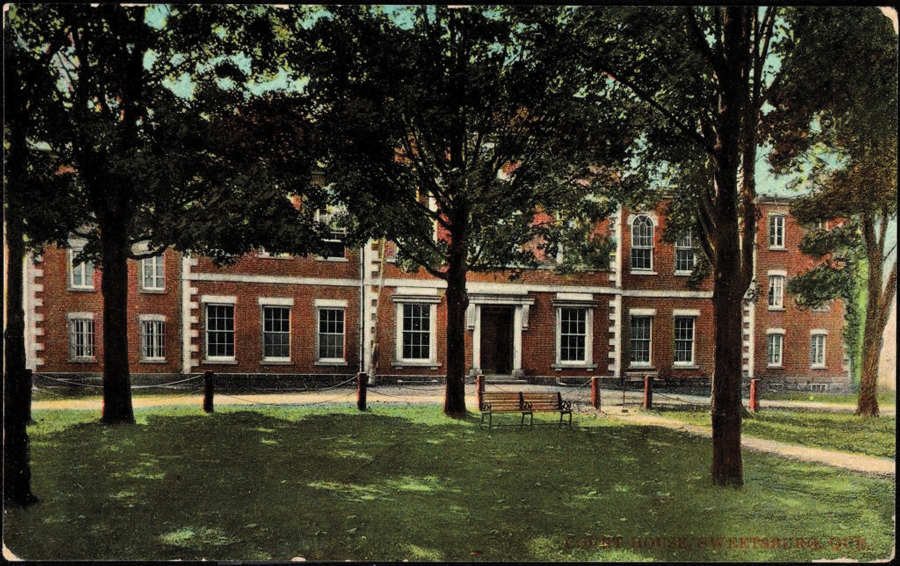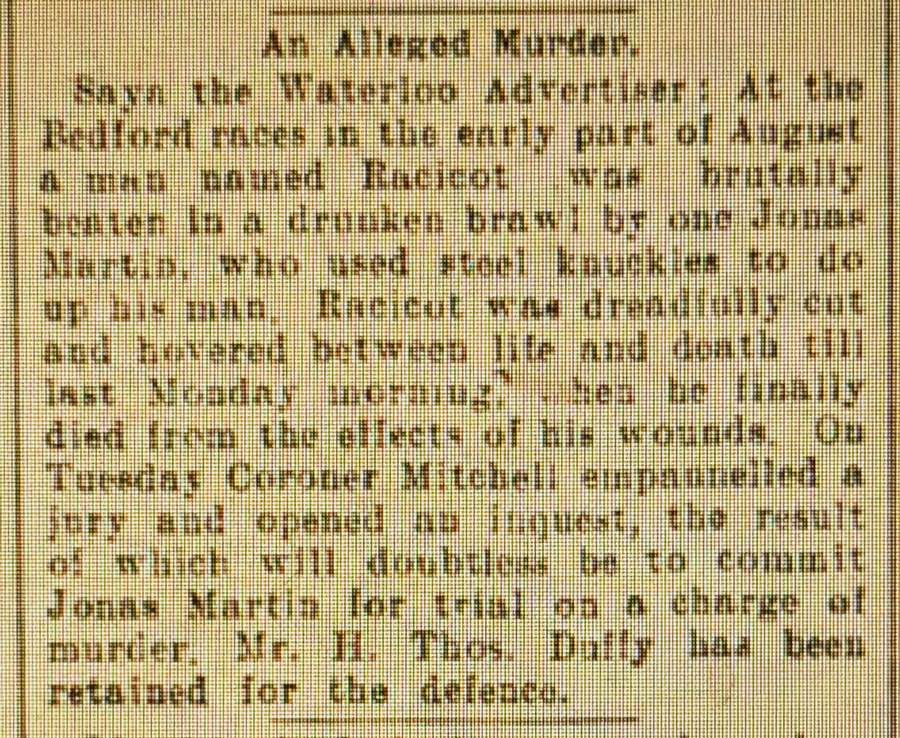The Devil’s in the Details

Un texte de Heather Darch
Paru dans le numéro Automne/Fall 2023
Publié le : 16 août 2023
Dernière mise à jour : 21 août 2023
Most details within the Martin legend are not quite true, but it shows that in far-fetched family stories, there is an essence of truth.
Legendary tales can be unusual. Take for example, the “Legend of the “Martin Band of Outlaws.” As the story is told, the Martin family, headed by “Hairy” Martin, farmed and lived in a log cabin in Stanbridge Township, Quebec. Hairy Martin was a big redheaded brute “without conscience, morals or any sense of decency.” He was “always up to some deviltry” and nick-named Hairy because of the abundant red hair that covered his body. Hairy had two sons named Henry and Jonas. The boys were more unruly than their father and the three of them took sport in abusing neighbours and women. One day for sport, Hairy hung his wife upside-down in the snow while his sons threw buckets of water on her.
Following a night of drinking at the Tarte Hotel in Bedford, Jonas Martin murdered a local man. He was arrested and tried in Sweetsburg (Cowansville). He was found guilty of first-degree murder, punishable by hanging, but his neighbour Judge Lynch, who was fearful of retribution, only gave him a light sentence. Jonas broke out of jail to find the witness who gave testimony against him and burned out his eyes with a red-hot poker. He then escaped to the United States where he remarried. Driven to madness by his cruelty, the second bride shot him in the head. As legends go, it’s an astonishing story for Missisquoi County, but it’s also not entirely true.
The boys became well-known horse thieves and eventually married dastardly women in their own right. When Henry and his wife Ammer Unwin could not have children, Jonas and his wife Jewell Rittenberg, swapped one of their many children for a white stallion. The wives even deceptively finished off Old Hairy with a plate of poisoned cookies and travelling salesmen were known to go missing after visiting the Martin households.
Henry Martin Sr., born in 1817 in Christieville (Iberville) Quebec, married Mary Campbell of Stanbridge East in 1839. Together, they had 12 children including Henry Walter Martin Jr. born in 1842 and Jonas in 1846. The Martin family did indeed live in a log cabin and Henry Sr., also known as “Harry,” was listed as a “lime burner” in the 1891 Census. He died in 1898 of old age, not by misfortune. Unfortunately, there is no record for Mary’s death and not surprisingly, the personal details of her domestic life remain unknown.
Henry Jr. married Ellen Elizabeth Unwin (1844-1878) around 1866. They did not need to exchange a horse for a child as they had three children together. Sadly, a two-year-old daughter died in 1874 and Ellen died four years later. In 1884, Henry Jr. remarried Julia Rittenberg and they had a son in 1886. The family lived in Bedford in 1901, but by the 1911 census, Julia is identified as a widow. Most of the Martins were buried in the Basswood cemetery near Bedford, QC.
By 1871, Jonas is married to a woman named Emma (a.k.a. Ama, Ammer or Amor.) Her name changes depending on the census taker and her last name is also unknown. This couple was childless. Jonas legally owned and sold horse “trotters;” competing with them in Vermont and at the Bedford Fair.
Following horse races in Bedford in August 1892, a large crowd gathered at Poissant’s Hotel to celebrate the day’s events. Among the gathering was Gregoire-Isaie Racicot (1833-1892) and Jonas Martin. The two men got into a drunken altercation and Racicot threw a punch. In self defence, Jonas hit back wearing “steel knuckles on his right hand.” Racicot lingered in a comatose state for days before dying of a brain hemorrhage. The coroner, Dr. H.E. Mitchell, opened an inquest and after interviewing many witnesses, he deemed that Jonas was culpable in causing the death of Racicot and ordered his arrest and imprisonment in the Sweetsburg jail to await trial.
In pre-trial newspaper accounts, one reporter noted that “the prisoner’s reputation as an all-around bad man will be apt to tell against him, both with Judge and Jury.” In February 1893, Jonas pleaded “not guilty” before his Stanbridge East school mate, Justice W.W. Lynch, and a jury of “intelligent looking men.”
Witnesses confirmed that while Racicot had started the fight, Jonas had ended it with steel knuckles to the back of Racicot’s head. In a “CSI-style” of defence, attorney H. Thomas Duffy used a life-sized mannequin to explain to the jury how Racicot could have died by his fall rather than a blow to the skull. Henry Martin Jr. testified in his brother’s defence too, but since he was not at the Hotel, his statement was dismissed. After a brief deliberation, the jury returned with the verdict “guilty of manslaughter” and a sentence of 5 years in the penitentiary. In a moment of weakness, Jonas cried.
Assuming he served his full sentence, Jonas would have been released in 1898. His name appears again in a 1904 immigration record to the United States. By 1910, he is a 64-year-old stone cutter married to a much younger widow named Ophelia Everson Brinkerhoff in Hudson, New Jersey. It’s probable that Emma Martin passed away between 1891 and 1904. In December 1911, Jonas died, ironically of a brain hemorrhage, and was buried in the Everson’s cemetery plot.
Most of the details within the Martin legend are not quite true. Relationships are skewed, names are inaccurate and some elements like horse thieving and Mary Campbell’s distressing story, simply cannot be verified. It goes to show however, that even in far-fetched family stories, there is an essence of truth.
Heather Darch
Sources:
Foster Wightman, “The legend concerning the Martin band of outlaws,” in Birth of Missisquoi County, 1960. Missisquoi Historical Society collections.
1842; Lower Canada Census, MG 31 C1, Affiliate Film Number C-732, Vol. No. 46, Pg No 2567.
Census Stanbridge, Missisquoi, Canada East (Quebec)
1851: Roll: C-1128
1861: Roll: C-1297
1871: Roll: C-10071;
1881: Roll: C_13204;
1891: Census Bedford Town, Missisquoi, Quebec, Canada; Roll: T-6403; Family No: 245
1901: Census Bedford, Missisquoi, Quebec; Page: 1; Family No: 6
1910; Census Jersey City Ward 11, Hudson, New Jersey; Roll: T624_892; Page: 11a; Enumeration District: 0207; FHL microfilm: 1374905
“Montreal Daily Herald,” August 27, 1892. https://numerique.banq.qc.ca/patrimoine/details/52327/4285207
“The Waterloo Advertiser,” Friday September 2, 1892 and February 10, 1893.
Quebec, Canada, Vital and Church Records (Drouin Collection), 1621-1968, Stanbridge East Anglican Church and la paroisse de Saint-Damien, Bedford Qc
John Hankins Wallace, “Wallace’s Monthly,” Volume 11, 1885 p. 541.


